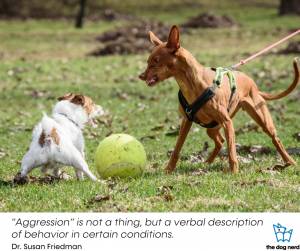(Disclaimer: It is not my goal to diminish the problem. Aggressive behaviors are not acceptable in our society and showing them can have serious consequences for the dog and their owner, as well as for the victim. Living with an aggressive dog can also cause a lot of stress and anxiety for the owner. It might be a good idea to see a therapist yourself!)
“Aggression” is one of the most frequent reasons for seeking out professional help. Basically, any strong reaction (barking, lunging, snapping) in any context can get labeled as “aggression” and people usually assume bad intent behind it. While some dogs certainly aim to bite, many – if not most – show aggressive behaviors simply in order to get more space. When dealing with any kind of problems, it is important to separate our narrative from the facts.
This post examines what aggression is and how it can be analyzed. Catch up on what aggression isn’t in part one.
So what is aggression?
In preparation for the aggression in dogs conference, Michael Shikashio – an American trainer working exclusively with aggression cases – asked people from different fields for their thoughts on this topic. These are the answers he got:
Ken Ramirez, animal trainer, Karen Pryor Academy:
“Any unwanted agonistic behavior.”
Sue Sternberg, behavior expert and an innovator in the field of shelter dog welfare, Dogs Of Course
“Intent to do harm or violence, if [we talk about dogs] it doesn’t just include the teeth, violence can be through physical damage from nails, claws, knocking somebody over, pinning them against the wall.”
Dr. Roger Abrantes, ethologist, Ethology Institute Cambridge
“Aggressive behavior is behavior with the function to eliminate competition from an opponent by injuring it, inflicting pain or giving a reliable warning of such impending consequences if it [the opponent] takes no evasive action.
(…) Aggressive behavior ranges from a reliable warning of impending damaging behavior, such as growling, roaring and stomping, to injurious behaviors, such as biting, staging and kicking. Predatory behavior is not aggressive behavior.
“Aggressive” is in ethology an adjective of behavior and not of an individual. Thus, the correct statement is “individual A displays aggressive behavior”, rather than “individual A is aggressive”.”
Dr. Susan Friedman, applied behavior analyst, Behavior Works
“…”aggression” is not a thing, but a verbal description of behavior in certain conditions.”
Aggression is not one thing: the many lenses of aggression
In order to understand any behavior, we need to ask the right questions:
- What is the animal doing, under what conditions? What is their reinforcement history? (the applied behavior analysis lense)
- Is there an underlying medical condition? (the medical lense)
- Why has this animal evolved to use these behaviors? (the ethological lense)
- What internal processes are affecting the dog’s behavior? (the cognitive lense)
None of these lenses is “better” or “more correct” than others but their relevance varies for each individual case. As you can see, aggression is not one thing and the sooner we acknowledge that, the better, more effectively and more humanely we can help animals in our care.

